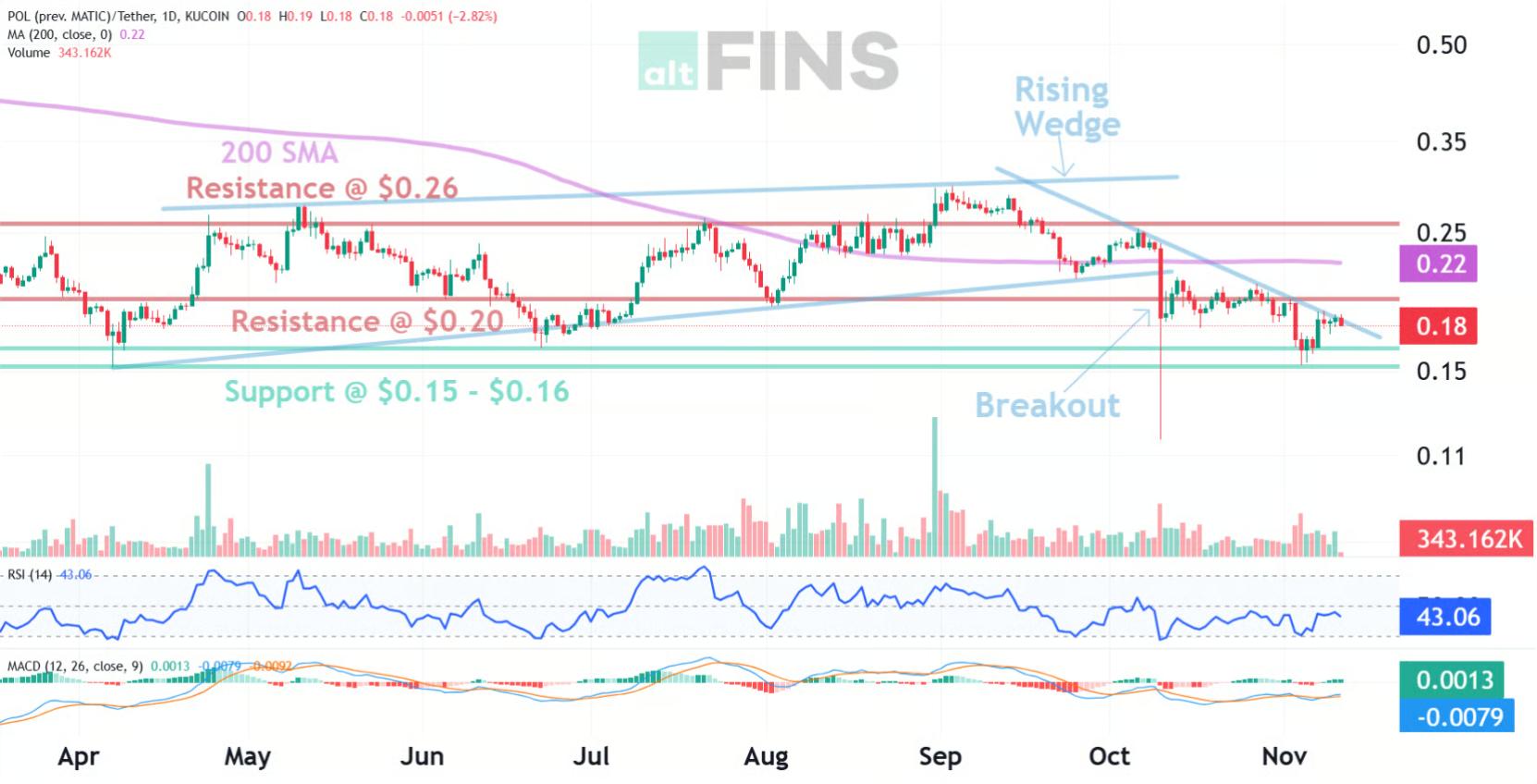Polygon (POL) Analysis
In addition to automated chart patterns, altFINS’ analysts conduct technical chart analyses of top 30 cryptocurrencies. We call these Curated Charts and they evaluate 5 core principals of technical analysis: Trend, Momentum, Patterns, Volume, Support and Resistance. Explore Polygon (POL) Analysis.
Polygon (POL) Trends
Polygon (POL) Performance
Polygon (POL) RSI & MACD
Polygon (POL) technical analysis:
Trade setup: Following a bearish breakout from Rising Wedge, below 200 SMA, price signaled resumption of downtrend. It’s rebounding from $0.15-$0.16 support zone but remains firmly in a Downtrend until it regains the 200 SMA level ($0.22).
Pattern: Price is Approaching Resistance, which is a level where it could pause or reverse its recent advance, at least temporarily. Resistance is often a level where price got rejected in the past, or potentially prior Support level that was broken. (concept known as polarity). Once price breaks above resistance, it can advance higher to the next resistance level. Learn to trade key levels in Lesson 7.
Trend: Short-term trend is Down, Medium-term trend is Strong Down, Long-term trend is Strong Down.
Momentum: Price is neither overbought nor oversold currently, based on RSI-14 levels (RSI > 30 and RSI < 70).
Support and Resistance: Nearest Support Zone is $0.15.
Nearest Resistance Zone is $0.26, then $0.30.

See more curated charts for top 60+altcoins.
Recent news and research:
Polygon nears $100B volume mark – Factors that will help POL
Polygon Launches AggLayer v0.2 Testnet to Enhance Blockchain Interactions
Polygon (MATIC) Teases Major Announcement
Binance NFT ends Sandbox staking and drops Polygon network support
MATIC Drops 6% as Polygon Labs Slashes Headcount by 20%
Polygon to Deliver Zero-Knowledge Powered Rollup
Polygon Working to Become ‘True Layer 2’
Polygon Raises $450M From Sequoia Capital India, Galaxy, SoftBank to Support Web 3 Plans
Sunflower Game Throws Wrench in Polygon’s Gears
Polygon leads NFT gaming growth while Axie Infinity, Decentraland retain “powerhouse” status
Polygon’s MATIC Primed to Revisit All-Time Highs
Kyber Partners with Polygon to Enhance DeFi Liquidity
As market slumps, Ren bolsters DeFi liquidity via Fantom, Polygon integrations
3 reasons why Polygon (MATIC) outperformed Bitcoin and major cryptos this week
ERC20 versions of Bitcoin, Dogecoin, and others get a ‘bridge’ to Polygon
Here’s What Billionaire Mark Cuban Checks Before Investing In A Blockchain Project
Find more real-time news here.
What is Polygon (POL)?
Find full description and news on altFINS platform.
Overview
A platform called Polygon was created to aid in the growth of Ethereum’s infrastructure and scale. Its main component is a modular, adaptable framework (Polygon SDK) that enables programmers to create and link Layer-2 infrastructures like Plasma, Optimistic Rollups, zkRollups, and Validium as well as independent sidechains like the project’s flagship product, Matic POS (Proof-of-Stake). In February 2021, Polygon, formerly known as PO Network, changed its name and shifted its focus to supporting various Layer-2 infrastructure. The Matic POS sidechain and Plasma-based payment system, which is presently home to over 90 apps, will still be supported.
History
In 2017, Polygon debuted as Matic Network. To address challenges with blockchain scale and usability, Jaynti Kanani, Sandeep Nailwal, and Anurag Arjun co-founded it. High transaction fees and latency for traditional blockchains might impede their adoption, technological efficiency, and user experience. For networks that can’t automatically grow as user activity rises, load-balancing can be performed through layer-2 scaling solutions or external networks. Matic included a plasma-driven scaling strategy and Proof-of-Stake (PoS) sidechains to help Ethereum as user demand for the network rose. In 2017, Plasma was at the vanguard of blockchain scaling. Matic POS evolved as a well-known scalable choice for several applications. In February 2021, Matic changed its name to Polygon to position itself as a Swiss Army knife for scaling solutions. Rollup and Validium functionality will be added by Polygon to its already functional Plasma/POS chain. The team is aware that a single solution by itself might not be able to grow Ethereum. Polygon aspires to play a key role in providing the infrastructure required to establish any of these systems. It is possible that several solutions may co-exist and help expand Ethereum collectively.
Supply Curve Details
After the sale, IEO (initial exchange offering) tokens became unlocked. At the moment of launching, half of all private sale tokens were unlocked, while the remaining tokens vested after six months (October 2019). Here you may find information about the remaining token release timetable.
Token Usage Details
POL ex.MATIC is Polygon’s native token. These are the functions of this token: Fees: The main purpose of the POLtoken is to cover network transaction fees. The token is intended to be a utility token that serves as the medium of exchange for payments and settlements among users interacting with the Polygon ecosystem. Staking: The Proof-of-Stake (PoS) layer used by POL sidechains to guarantee consensus requires that network users stake POL in order to act as validators and get staking incentives. Several operations on the Polygon Network, like verifying blocks and posting proofs, call on computational resources. POL inflation encourages these resource providers to bootstrap security and uphold network integrity by rewarding them.
About altFINS
altFINS is the best crypto analytics platform. The platform will help you find the right crypto trading opportunities. You can search for coin in Uptrend, with Momentum or Breakouts. It’s is great for advanced traders but also for beginners to learn basics of technical analysis in Crypto trading Course or in Curated charts or Chart pattern sections. But also more advanced traders can create their own Screens and Alerts of coins with different trading strategies.
